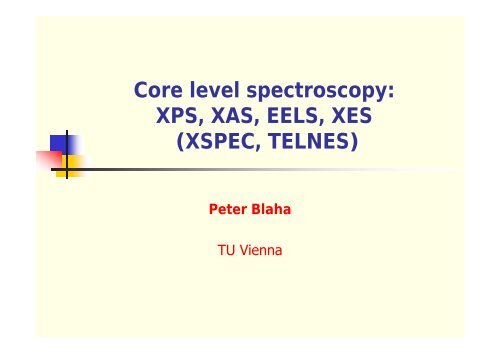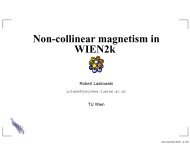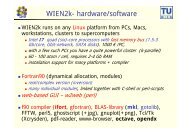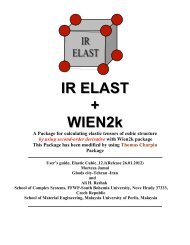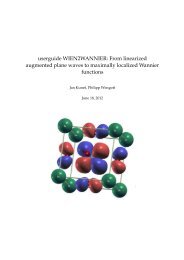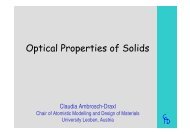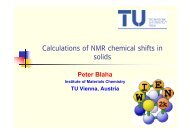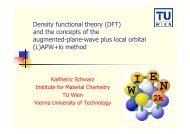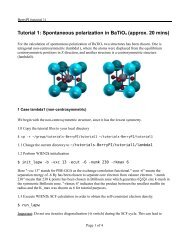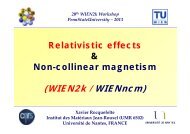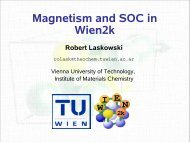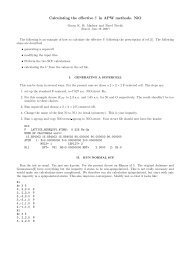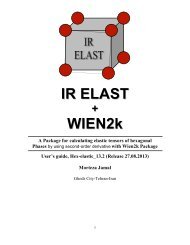Core level spectroscopy: XPS, XAS, EELS, XES (XSPEC ... - WIEN 2k
Core level spectroscopy: XPS, XAS, EELS, XES (XSPEC ... - WIEN 2k
Core level spectroscopy: XPS, XAS, EELS, XES (XSPEC ... - WIEN 2k
You also want an ePaper? Increase the reach of your titles
YUMPU automatically turns print PDFs into web optimized ePapers that Google loves.
<strong>Core</strong> <strong>level</strong> <strong>spectroscopy</strong>:<br />
<strong>XPS</strong>, <strong>XAS</strong>, <strong>EELS</strong>, <strong>XES</strong><br />
(<strong>XSPEC</strong>, TELNES)<br />
Peter Blaha<br />
TU Vienna
<strong>XPS</strong>, core-<strong>level</strong> shifts<br />
• Ionizationpotential of core-e - , IP= E tot (N) – E tot (N-1)<br />
• gives information on charge state of the atom<br />
• core-eigenvalues i are NOT a good approximation: i =dE/dn<br />
E<br />
• Slater’s “transition state”:<br />
• core-eigenvalues i for half occupancy<br />
E<br />
secant ~ tangent at N-½<br />
N N-1<br />
occup.<br />
• -SCF-calculation with and without core-hole: E tot (N) – E tot (N-1)<br />
• supercells to reduce hole-hole interaction<br />
C,N 1s exp.(eV) i -SCF<br />
TiC 281.5 264.7 281.9<br />
Ti 4 C 4 281.5 263.3 281.1<br />
TiN 397.0 377.5 397.1
<strong>XAS</strong> (XANES), <strong>EELS</strong> (ELNES), <strong>XES</strong>:<br />
• core electrons are excited into a<br />
conduction band<br />
• Each core shell introduces an absorption<br />
edge, (they are indexed by the principal<br />
number of a core <strong>level</strong>)<br />
K-1s, L 1 -2s, L 2 -2p 1/2 , L 3 -p 3/2<br />
• <strong>XES</strong>:<br />
knock out a core electron, valence electron<br />
fills core hole and hv is emitted<br />
L 3<br />
L 2<br />
L 1<br />
K<br />
2p 3/2<br />
2p 1/2<br />
2s<br />
1s<br />
SOC<br />
core<br />
<strong>level</strong>s
X-ray absorption <strong>spectroscopy</strong> - <strong>XAS</strong><br />
Electron energy loss <strong>spectroscopy</strong> - <strong>EELS</strong><br />
X-ray Absorption<br />
Near-Edge Structure<br />
Extended X-ray<br />
Absorption Fine Structure<br />
Absorption<br />
1.6<br />
1.4<br />
<strong>EELS</strong> spectrum of various<br />
TM oxides<br />
1.2<br />
1.0<br />
XANES<br />
EXAFS<br />
17000<br />
17200<br />
17400<br />
17600<br />
17800<br />
18000<br />
Energy (eV)
Difference between <strong>EELS</strong> and <strong>XAS</strong>
<strong>XAS</strong> vs. <strong>EELS</strong>: theory<br />
• transition described by Fermis “golden rule” between initial<br />
(core) and final (conduction-band) state and the e - or photon<br />
• double differential cross section:<br />
E - conservation<br />
single diff. cross section<br />
momentum transfer q<br />
polarization vector e
dipole approximation<br />
(TELNES3 can also handle non-dipole transitions + relativistic corrections)<br />
core-valence spectroscopies give information<br />
on the local DOS (because of < core |r| val >)<br />
of angular momentum character l ±1
“Final state rule”:<br />
“Final state” determines the spectrum:<br />
• Emission <strong>spectroscopy</strong>:<br />
Final state has filled core, but valence hole.<br />
This is usually well screened, thus one “sees” the groundstate.<br />
• Absorption <strong>spectroscopy</strong>:<br />
Final state has a “hole” in core state, but additional e - in conduction band.<br />
<strong>Core</strong>-hole has large effect on the spectrum<br />
• electron – hole interaction, “excitonic effects”<br />
.
Treating the core hole within <strong>WIEN</strong><strong>2k</strong><br />
• No core hole (= ground state, sudden approximation)<br />
• usually not a good approximation (maybe in metals )<br />
• Z+1 approximation (eg., replace C by N)<br />
• also not very good<br />
• <strong>Core</strong>-hole (supercell) calculations:<br />
• Remove 1 core electron on ONE atom in the supercell, add 1 electron<br />
to conduction band<br />
• Remove 1 core electron, add 1 electron as uniform background charge<br />
• considers statically screened e - - h coulomb correlation<br />
• Fractional core hole (consider different screening)<br />
• Explicit treatment of electron-hole interaction (excitonic<br />
effects) using Bethe-Salpeter equation (BSE)
“Final state rule” + core hole:<br />
2x2x2 supercell calculation, with<br />
core hole in one of the Mg atoms.<br />
This allows the conduction state to<br />
relax (adjust to the larger effective<br />
nuclear charge), but also to have<br />
static screening from the environment.<br />
exp<br />
MgO<br />
core hole, no supercell:<br />
Z+1 (AlO)<br />
groundstate
<strong>XAS</strong> / TELNES in <strong>WIEN</strong><strong>2k</strong><br />
define your structure (structgen)<br />
initialize calculation (init_lapw)<br />
run scf-cycle (run_lapw)<br />
geometry optimization of your structure (min_lapw)<br />
generate supercell (x supercell)<br />
initialize supercell structure, define core hole/add valence e -<br />
run scf-cycle<br />
remove extra valence e -<br />
run <strong>XSPEC</strong> / TELNES3 task
<strong>XSPEC</strong>-task
TELNES3 task
B-K XANES in h-BN/Ni(111)<br />
• B-K edge in BN and BN/Ni(111)<br />
• Preobrajenski etal, PRB70, 165404 (2004): “The experiments<br />
contradict recent DFT calculations by Grad etal.”<br />
A’<br />
A’’
• aaa<br />
Angle dependency of B-K edge in h-BN/Ni(111)<br />
-bands (they interact with Ni!)<br />
B-p xy<br />
B-p z<br />
B-p
Partial core hole screening in the Cu L 3 edge<br />
• J.Luitz et al., Eur. Phys. J. B 21, 363{367 (2001)<br />
0.5e corehole<br />
experiment<br />
without<br />
corehole<br />
with<br />
corehole<br />
Unexpected effect of core-hole !
L 2,3 spectra: failure of the single particle approach<br />
• In particular early 3d TM-compounds show a<br />
• non-standard L 2 /L 3 branching ratio (1:2)<br />
• sometimes a completely different lineshape (TiO 2 )<br />
• „wrong“ SOC or CF splittings<br />
• rutile TiO 2 CaF 2<br />
L 3 L 2<br />
soc<br />
exp.<br />
CF<br />
exp.<br />
ground state calc.<br />
core-hole calc.
Beyond IPA<br />
●<br />
ab-initio configuration interaction (solid is approximated by<br />
finite cluster)<br />
Y. Kumagai, H. Ikeno, and I. Tanaka, J. Phys.: Condens. Matter 21, 104209 (2009).<br />
H. Ikeno, F. M. F. de Groot, S. E., and I. Tanaka, J.Phys.: Condens. Matter 21, 104208<br />
(2009).<br />
H. Ikeno and I. Tanaka, Phys. Rev. B 77, 075127 (2008).<br />
●<br />
linear response in time dependent DFT (TDDFT)<br />
J. Schwitalla and H. Ebert, Phys. Rev. Lett. 80, 4586 (1998).<br />
A. L. Ankudinov, A. I. Nesvizhskii, and J. J. Rehr, Phys.Rev. B 67, 115120 (2003).<br />
●<br />
Bethe- Salpeter equation (BSE)<br />
E. L. Shirley, J. Electron Spectrosc. Relat. Phenom. 144-147, 1187 (2005).<br />
E. L. Shirley, Phys. Rev. Lett. 80, 794 (1998).<br />
J. A. Soininen and E. L. Shirley, Phys. Rev. B 64, 165112 (2001).<br />
W. Olovsson, I. Tanaka, T. Mizoguchi, P. Puschnig, and C. Ambrosch-Draxl, Phys. Rev.<br />
B 79, 041102 (2009).<br />
R. Laskowski, P. Blaha, Phys. Rev. B, 81, 075418 (2010)
fully relativistic electron-hole interaction (BSE)<br />
• Bethe-Salpeter-equation: L(12;1’2’)<br />
• solving a 2-particle (e - - h) equation of<br />
large dimension ( N v N c N k ~ 100000)<br />
H<br />
H<br />
H<br />
H<br />
eh<br />
diag<br />
H<br />
dir<br />
vckv ' c'<br />
k '<br />
x<br />
vckv ' c'<br />
k '<br />
diag<br />
( E<br />
<br />
<br />
v,<br />
k<br />
<br />
<br />
<br />
H<br />
d<br />
<br />
d<br />
3<br />
r<br />
3<br />
E<br />
r<br />
d<br />
dir<br />
c,<br />
k<br />
d<br />
3<br />
2H<br />
) <br />
3<br />
cc '<br />
r'<br />
<br />
r'<br />
<br />
<br />
vk<br />
vv '<br />
vk<br />
x<br />
<br />
kk '<br />
eigenvalue difference between hole (v) and electron(c) state<br />
( r)<br />
<br />
( r)<br />
<br />
*<br />
ck<br />
*<br />
ck<br />
( r'<br />
) W ( r,<br />
r'<br />
) <br />
( r)<br />
v ( r,<br />
r'<br />
) <br />
*<br />
v'<br />
k '<br />
*<br />
v'<br />
k '<br />
( r)<br />
<br />
attractive screened static Coulomb interaction W; W~ -1<br />
e-h exchange with bare Coulomb potential v<br />
( r'<br />
) <br />
c'<br />
k '<br />
c'<br />
k '<br />
( r'<br />
)<br />
( r'<br />
)<br />
Excitons in LiF
• “ground-state” DOS<br />
Ca-L 23 edge in CaF 2<br />
• “core-hole” calc.(ratio 2:1)<br />
• BSE for L 2 and L 3 separately<br />
• experiment<br />
• BSE with p 1/2 and p 3/2 together<br />
• BSE without direct term H eh<br />
dir<br />
• BSE without exchange term H eh<br />
x
L 2,3 edge for Ca in CaF 2<br />
L 3 L 2<br />
Decomposition of є 2 into the excitation from p 1/2 and p 3/2 states<br />
cross terms suppress the L 3 branch and enhance L 2
Ti L 2,3 in rutile-TiO 2 , anatase-TiO 2 , SrTiO 3<br />
L 3 L 2 t 2g e g<br />
● The experimental Ti L 2,3 edges<br />
are rather well reproduced.<br />
● intensity ratio L 3 /L 2 (not 2:1)<br />
● „t 2g /e g “ ratio (not 3:2)<br />
● left/right shoulder in L 3 -„e g “ peak<br />
of rutile/anatase
Ti L 2,3 in SrTiO 3 , decomposition of є 2<br />
Decomposition into excitations<br />
from p 1/2 and p 3/2<br />
L 3 L 2<br />
e g<br />
cross term suppresses the L 3<br />
branch and enhances the L 2<br />
Decomposition into excitation into<br />
the e g and t 2g bands<br />
the first peak of L 2 or L 3 is related<br />
to excitations into t 2g , the second<br />
peak is associated with e g<br />
the cross term strongly modifies<br />
the ratio between these peaks<br />
t 2g<br />
Sr<br />
Ti<br />
O
3d metal L 2,3 branching ratio<br />
Ti L 2,3 branching ratio in rutile-TiO 2<br />
(SOC splitting is set to values<br />
from 5eV to 25eV)<br />
The size of spin orbit<br />
splitting is a main factor<br />
determining the branching<br />
ratio (deviating from 0.5)
fcc Ca, L 2,3 edge<br />
L 3<br />
L 2<br />
L 2<br />
L 3
Acknowledgement<br />
“Practical aspects of running the <strong>WIEN</strong><strong>2k</strong> code for electron <strong>spectroscopy</strong>”,<br />
C.Hebert, Micron 38 (2007) 12–28<br />
Acknowledgement:<br />
TELNES: P.Schattschneider, M.Nelhiebel, C.Hebert (TU Vienna)<br />
K.Jorissen (Univ. Washington)<br />
BSE: R.Laskowski (TU Vienna)<br />
C.Ambrosch-Draxl<br />
<strong>WIEN</strong><strong>2k</strong>: K.Schwarz, J. Luitz<br />
Thank you for your attention !


